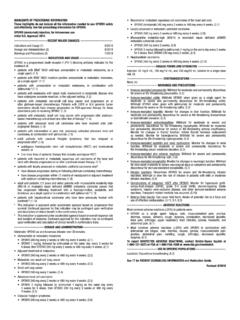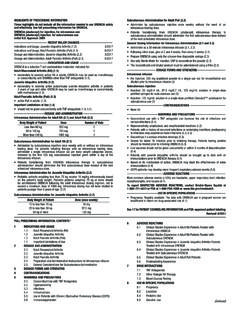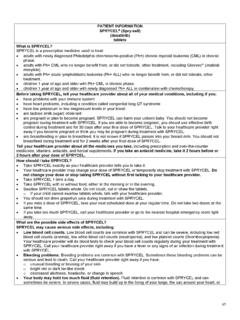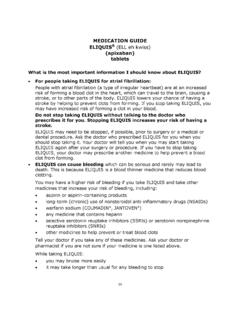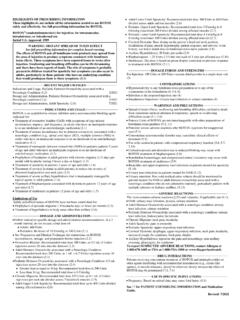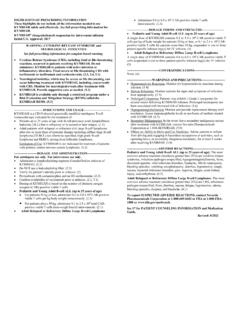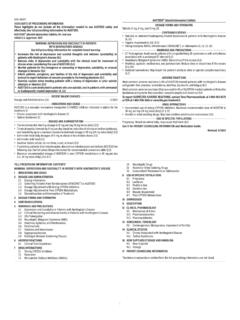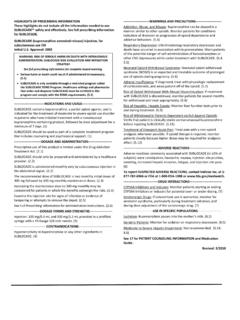Transcription of Prophylaxis of DVT following hip or knee replacement ...
1 FULL prescribing information : CONTENTS*WARNING: (A) PREMATURE DISCONTINUATION OF ELIQUIS INCREASES THE RISK OF THROMBOTIC EVENTS (B) SPINAL/EPIDURAL HEMATOMA1 INDICATIONS AND Reduction of Risk of Stroke and Systemic Embolism in Nonvalvular Atrial Prophylaxis of Deep Vein Thrombosis following Hip or Knee replacement Treatment of Deep Vein Treatment of Pulmonary Reduction in the Risk of Recurrence of DVT and PE2 DOSAGE AND Recommended Missed Temporary Interruption for Surgery and Other Converting from or to Combined P-gp and Strong CYP3A4 Administration Options3 DOSAGE FORMS AND STRENGTHS4 CONTRAINDICATIONS5 WARNINGS AND Increased Risk of Thrombotic Events after Premature Spinal/Epidural Anesthesia or Puncture Patients with Prosthetic Heart Acute PE in Hemodynamically Unstable Patients or Patients who Require Thrombolysis or Pulmonary Increased Risk of Thrombosis in Patients with
2 Triple Positive Antiphospholipid SyndromeHIGHLIGHTS OF prescribing INFORMATIONT hese highlights do not include all the information needed to use ELIQUIS safely and effectively. See full prescribing information for (apixaban) tablets, for oral useInitial Approval: 2012 WARNING: (A) PREMATURE DISCONTINUATION OF ELIQUIS INCREASES THE RISK OF THROMBOTIC EVENTS(B) SPINAL/EPIDURAL HEMATOMASee full prescribing information for complete boxed warning.(A) PREMATURE DISCONTINUATION OF ELIQUIS INCREASES THE RISK OF THROMBOTIC EVENTS: Premature discontinuation of any oral anticoagulant, including ELIQUIS, increases the risk of thrombotic events. To reduce this risk, consider coverage with another anticoagulant if ELIQUIS is discontinued for a reason other than pathological bleeding or completion of a course of therapy.
3 ( , , )(B) SPINAL/EPIDURAL HEMATOMA: Epidural or spinal hematomas may occur in patients treated with ELIQUIS who are receiving neuraxial anesthesia or undergoing spinal puncture. These hematomas may result in long-term or permanent paralysis. Consider these risks when scheduling patients for spinal procedures. ( )------------------------------RECENT MAJOR CHANGES ------------------------------Warnings and Precautions, Increased Risk of Thrombosis in Patients with Triple Positive Antiphospholipid Syndrome ( ) 11/2019-------------------------------IN DICATIONS AND USAGE ------------------------------ELIQUIS is a factor Xa inhibitor indicated: to reduce the risk of stroke and systemic embolism in patients with nonvalvular atrial fibrillation. ( ) for the Prophylaxis of deep vein thrombosis (DVT), which may lead to pulmonary embolism (PE), in patients who have undergone hip or knee replacement surgery.
4 ( ) for the treatment of DVT and PE, and for the reduction in the risk of recurrent DVT and PE following initial therapy. ( , , )---------------------------DOSAGE AND ADMINISTRATION --------------------------- Reduction of risk of stroke and systemic embolism in nonvalvular atrial fibrillation: The recommended dose is 5 mg orally twice daily. ( ) In patients with at least 2 of the following characteristics: age greater than or equal to 80 years, body weight less than or equal to 60 kg, or serum creatinine greater than or equal to mg/dL, the recommended dose is mg orally twice daily. ( ) Prophylaxis of DVT following hip or knee replacement surgery: The recommended dose is mg orally twice daily. ( ) Treatment of DVT and PE: The recommended dose is 10 mg taken orally twice daily for 7 days, followed by 5 mg taken orally twice daily.
5 ( ) Reduction in the risk of recurrent DVT and PE following initial therapy: The recommended dose is mg taken orally twice daily. ( )--------------------------DOSAGE FORMS AND STRENGTHS -------------------------- Tablets: mg and 5 mg (3)---------------------------------CONT RAINDICATIONS--------------------------- ------ Active pathological bleeding (4) Severe hypersensitivity to ELIQUIS (apixaban) (4)----------------------------WARNINGS AND PRECAUTIONS --------------------------- ELIQUIS can cause serious, potentially fatal, bleeding. Promptly evaluate signs and symptoms of blood loss. An agent to reverse the anti-factor Xa activity of apixaban is available. ( ) Prosthetic heart valves: ELIQUIS use not recommended. ( ) Increased Risk of Thrombosis in Patients with Triple Positive Antiphospholipid Syndrome: ELIQUIS use not recommended.
6 ( )---------------------------------ADVERS E REACTIONS --------------------------------Most common adverse reactions (>1%) are related to bleeding. ( )To report SUSPECTED ADVERSE REACTIONS, contact Bristol-Myers Squibb at 1-800-721-5072 or FDA at 1-800-FDA-1088 or INTERACTIONS -------------------------------- Combined P-gp and strong CYP3A4 inhibitors increase blood levels of apixaban. Reduce ELIQUIS dose or avoid coadministration. ( , , ) Simultaneous use of combined P-gp and strong CYP3A4 inducers reduces blood levels of apixaban: Avoid concomitant use. ( , )---------------------------USE IN SPECIFIC POPULATIONS --------------------------- Pregnancy: Not recommended. ( ) Lactation: Discontinue drug or discontinue nursing. ( ) Severe Hepatic Impairment: Not recommended.
7 ( , )See 17 for PATIENT COUNSELING information and Medication : 11/20196 ADVERSE Clinical Trials Experience7 DRUG Combined P-gp and Strong CYP3A4 Combined P-gp and Strong CYP3A4 Anticoagulants and Antiplatelet Agents8 USE IN SPECIFIC Pediatric Geriatric Renal Hepatic Impairment10 OVERDOSAGE11 DESCRIPTION12 CLINICAL Mechanism of Pharmacokinetics13 NONCLINICAL Carcinogenesis, Mutagenesis, Impairment of Fertility14 CLINICAL Reduction of Risk of Stroke and Systemic Embolism in Nonvalvular Atrial Prophylaxis of Deep Vein Thrombosis following Hip or Knee replacement Treatment of DVT and PE and Reduction in the Risk of Recurrence of DVT and PE16 HOW SUPPLIED/STORAGE AND HANDLING17 PATIENT COUNSELING information * Sections or subsections omitted from the full prescribing information are not (apixaban)FULL prescribing INFORMATIONWARNING: (A) PREMATURE DISCONTINUATION OF ELIQUIS INCREASES THE RISK OF THROMBOTIC EVENTS(B) SPINAL/EPIDURAL HEMATOMA(A) PREMATURE DISCONTINUATION OF ELIQUIS INCREASES THE RISK OF THROMBOTIC EVENTSP remature discontinuation of any oral anticoagulant, including ELIQUIS, increases the risk of thrombotic events.
8 If anticoagulation with ELIQUIS is discontinued for a reason other than pathological bleeding or completion of a course of therapy, consider coverage with another anticoagulant [see Dosage and Administration ( ), Warnings and Precautions ( ), and Clinical Studies ( )].(B) SPINAL/EPIDURAL HEMATOMAE pidural or spinal hematomas may occur in patients treated with ELIQUIS who are receiving neuraxial anesthesia or undergoing spinal puncture. These hematomas may result in long-term or permanent paralysis. Consider these risks when scheduling patients for spinal procedures. Factors that can increase the risk of developing epidural or spinal hematomas in these patients include: use of indwelling epidural catheters concomitant use of other drugs that affect hemostasis, such as nonsteroidal anti-inflammatory drugs (NSAIDs), platelet inhibitors, other anticoagulants a history of traumatic or repeated epidural or spinal punctures a history of spinal deformity or spinal surgery optimal timing between the administration of ELIQUIS and neuraxial procedures is not known[see Warnings and Precautions ( )]Monitor patients frequently for signs and symptoms of neurological impairment.
9 If neurological compromise is noted, urgent treatment is necessary [see Warnings and Precautions ( )].Consider the benefits and risks before neuraxial intervention in patients anticoagulated or to be anticoagulated [see Warnings and Precautions ( )].1 INDICATIONS AND Reduction of Risk of Stroke and Systemic Embolism in Nonvalvular Atrial FibrillationELIQUIS (apixaban) is indicated to reduce the risk of stroke and systemic embolism in patients with nonvalvular atrial Prophylaxis of Deep Vein Thrombosis following Hip or Knee replacement SurgeryELIQUIS is indicated for the Prophylaxis of deep vein thrombosis (DVT), which may lead to pulmonary embolism (PE), in patients who have undergone hip or knee replacement Treatment of Deep Vein ThrombosisELIQUIS is indicated for the treatment of Treatment of Pulmonary EmbolismELIQUIS is indicated for the treatment of Reduction in the Risk of Recurrence of DVT and PEELIQUIS is indicated to reduce the risk of recurrent DVT and PE following initial DOSAGE AND ADMINISTRATION Recommended DoseReduction of Risk of Stroke and Systemic Embolism in Patients with Nonvalvular Atrial FibrillationThe recommended dose of ELIQUIS for most patients is 5 mg taken orally twice recommended dose of ELIQUIS is mg twice daily in patients with at least two of the following characteristics.
10 Age greater than or equal to 80 years body weight less than or equal to 60 kg serum creatinine greater than or equal to mg/dLProphylaxis of Deep Vein Thrombosis following Hip or Knee replacement SurgeryThe recommended dose of ELIQUIS is mg taken orally twice daily. The initial dose should be taken 12 to 24 hours after surgery. In patients undergoing hip replacement surgery, the recommended duration of treatment is 35 days. In patients undergoing knee replacement surgery, the recommended duration of treatment is 12 of DVT and PEThe recommended dose of ELIQUIS is 10 mg taken orally twice daily for the first 7 days of therapy. After 7 days, the recommended dose is 5 mg taken orally twice in the Risk of Recurrence of DVT and PEThe recommended dose of ELIQUIS is mg taken orally twice daily after at least 6 months of treatment for DVT or PE [see Clinical Studies ( )].


